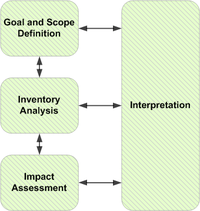
Photo from wikipedia
Introducing biosynthetic pathways into an organism is both reliant on and challenged by endogenous biochemistry. Here we compared the expansion potential of the metabolic network in the photoautotroph Synechocystis with… Click to show full abstract
Introducing biosynthetic pathways into an organism is both reliant on and challenged by endogenous biochemistry. Here we compared the expansion potential of the metabolic network in the photoautotroph Synechocystis with that of the heterotroph E. coli using the novel workflow POPPY (Prospecting Optimal Pathways with PYthon). First, E. coli and Synechocystis metabolomic and fluxomic data were combined with metabolic models to identify thermodynamic constraints on metabolite concentrations (NET analysis). Then, thousands of automatically constructed pathways were placed within each network and subjected to a network-embedded variant of the max-min driving force analysis (NEM). We found that the networks had different capabilities for imparting thermodynamic driving forces toward certain compounds. Key metabolites were constrained differently in Synechocystis due to opposing flux directions in glycolysis and carbon fixation, the forked tri-carboxylic acid cycle, and photorespiration. Furthermore, the lysine biosynthesis pathway in Synechocystis was identified as thermodynamically constrained, impacting both endogenous and heterologous reactions through low 2-oxoglutarate levels. Our study also identified important yet poorly covered areas in existing metabolomics data and provides a reference for future thermodynamics-based engineering in Synechocystis and beyond. The POPPY methodology represents a step in making optimal pathway-host matches, which is likely to become important as the practical range of host organisms is diversified.
Journal Title: Metabolic engineering
Year Published: 2018
Link to full text (if available)
Share on Social Media: Sign Up to like & get
recommendations!